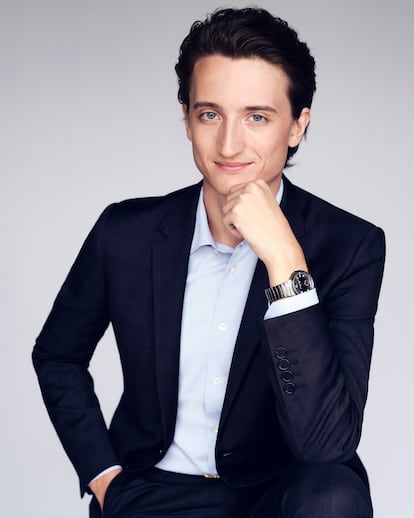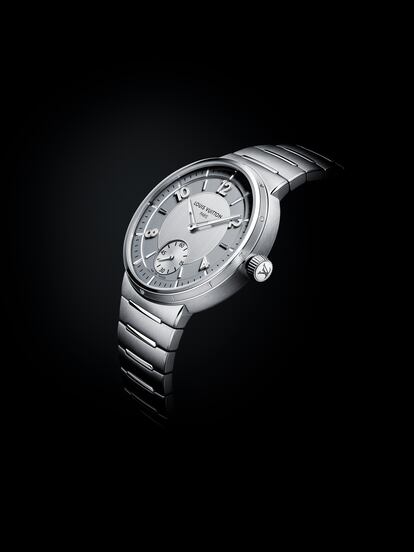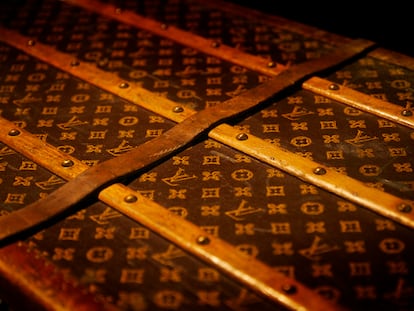Jean Arnault, the 25-year-old heir winding up Louis Vuitton’s watchmaking renaissance
At the head of the French watchmaking house, the youngest son of Bernard Arnault takes a triple (and luxurious) somersault with the new Tambour collection, a declaration of business ambition and love of craftsmanship and mechanics.

Jean Arnault (Paris, 25 years old) is passionate about mechanics. This is why it is meaningful that the epiphany that set the course of his professional career came to him precisely on a motor vehicle. “I studied mechanical engineering because I have always been passionate about car and airplane engines. My first passion was Formula 1. That is why I decided to study mechanical engineering in London,” he recalls. “I was lucky enough to spend a season at McLaren, and I used to take the train to go to Woking, to the team’s headquarters. During the journey, I started to read watchmaking blogs, to become interested in their mechanical details, in their design. And I got hooked.”
The youngest son of Bernard Arnault, the founder of French luxury giant LVMH, had discovered his calling, and he was in the right place to develop it. Since 2021, Jean Arnault has been the director of watches at Louis Vuitton, a business division that until a few years ago was a small part of the luxury brand, but which has just made a significant move to assert its presence. Last July, in a presentation at the Musée d’Orsay, the scene of many artistic revolutions — and, quite fittingly, against the backdrop of the museum’s enormous mechanical clock — Jean Arnault was delighted to present his first major project: a watch, yes, but also the sign of a fresh start. The new Tambour takes its name from its predecessors, called that way due to their drum-shaped case (“tambour” means “drum” in French), but it is completely new, and it is here to replace all the others. “It is the most important launch we have had in Louis Vuitton watchmaking since 2002,” says Arnault. “Because of the product, but also because of everything that surrounds it. Above all, the fact that we are withdrawing all the other collections is an important gesture for the brand. The underlying reflection is that, if we launch a watch at this price, with this quality and this attention to detail, we cannot have two or three different levels of quality in the same collection.”

In a sector defined by the obsession with the archival, where the main brands have several simultaneous lines, combining long-standing models and periodic updates for different audiences, Arnault’s bet for Vuitton watchmaking is a triple somersault: from now on, the previous Tambour models disappear to give way to a new generation of unisex mechanical models that preserve the essence of the collection, but raising the stakes, the prices and the internal coherence. “Unlike a plane or a car, a watch has no safety or regulatory restrictions, which allows us to be much more free and creative,” explains Arnault. “More than any other object, a watch works as a whole. That is to say, a good case with a good movement and a good bracelet. Everything at once. And I think we have achieved it.”
The campaign images show the watch in monochrome combinations that highlight that coherence: steel with a gray face, or yellow gold with a white face, like the one Leo Messi wore at the Ballon d’Or ceremony in October. The inaugural collection offers few variations because the fundamental goal is a high-precision design. Arnault draws attention to barely noticeable but essential details, such as the first five links of the bracelet. “There is a narrowing in them, so that they adapt better to the wrist,” he explains. “We had two options: to do it in a staggered way, with straight lines that gradually change angles, or with a sort of continuous curve. The net difference between both options is 0.1 millimeters, but 30% of the price. And we chose the curved option because it allowed for a more harmonious design. That is the level we are playing at.”

Arnault’s move is a gamble to reposition Louis Vuitton as a niche watchmaker. The prices confirm this (€19,500, or over $21,000 for the simplest model), but also the working methods. The Fabrique du Temps — the house’s watchmaking workshop, where these artisanal processes take place — is another rarity. “When I started to become interested in watchmaking I thought that all the brands worked the same way, with watchmakers making watches from start to finish. I soon realized that that was not the case; most companies work with assembly lines, like in the automobile industry. As soon as I arrived at Louis Vuitton, I saw that the production method and techniques were truly artisanal. In our workshops, the same watchmaker assembles each watch from start to finish. All that’s missing is their signature! It is something unique. We take craftsmanship to the limit, and that is not always economically efficient.”
When talking about his role models, Arnault mentions Roger Federer, his childhood idol. “It seems like a simple answer, but I have been passionate about tennis since I was a child. And I not only admire Federer for his successes, but also for his defeats. He has had moments of weakness, but the way he handles those defeats has always impressed me. He is a tennis player who always comes back, always goes for another Grand Slam.” His commitment to position Louis Vuitton at the pinnacle of watchmaking is also a statement of resilience that runs in the family. “My father has always told me the same thing: if the product is good, the results will come. Before joining Vuitton I didn’t have the vision to understand it, but now I get it. With the new Tambour we don’t expect impressive results right away, because it’s clearly a big move. But one day collectors, and our customers, will realize that these products are exceptional, that we have made no compromises, and they will begin to understand the philosophy behind them.”
Sign up for our weekly newsletter to get more English-language news coverage from EL PAÍS USA Edition
Tu suscripción se está usando en otro dispositivo
¿Quieres añadir otro usuario a tu suscripción?
Si continúas leyendo en este dispositivo, no se podrá leer en el otro.
FlechaTu suscripción se está usando en otro dispositivo y solo puedes acceder a EL PAÍS desde un dispositivo a la vez.
Si quieres compartir tu cuenta, cambia tu suscripción a la modalidad Premium, así podrás añadir otro usuario. Cada uno accederá con su propia cuenta de email, lo que os permitirá personalizar vuestra experiencia en EL PAÍS.
¿Tienes una suscripción de empresa? Accede aquí para contratar más cuentas.
En el caso de no saber quién está usando tu cuenta, te recomendamos cambiar tu contraseña aquí.
Si decides continuar compartiendo tu cuenta, este mensaje se mostrará en tu dispositivo y en el de la otra persona que está usando tu cuenta de forma indefinida, afectando a tu experiencia de lectura. Puedes consultar aquí los términos y condiciones de la suscripción digital.
More information
Archived In
Últimas noticias
Most viewed
- Sinaloa Cartel war is taking its toll on Los Chapitos
- Oona Chaplin: ‘I told James Cameron that I was living in a treehouse and starting a permaculture project with a friend’
- Reinhard Genzel, Nobel laureate in physics: ‘One-minute videos will never give you the truth’
- Why the price of coffee has skyrocketed: from Brazilian plantations to specialty coffee houses
- Silver prices are going crazy: This is what’s fueling the rally











































